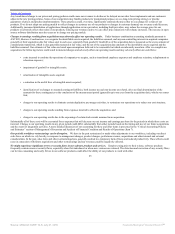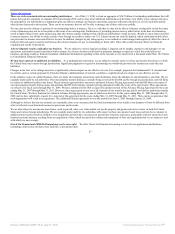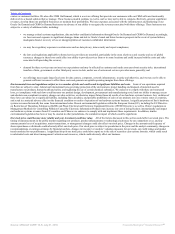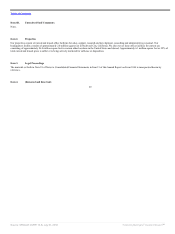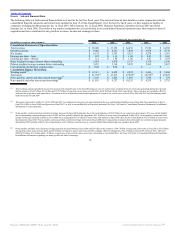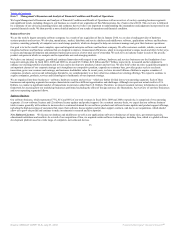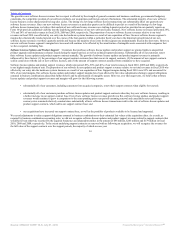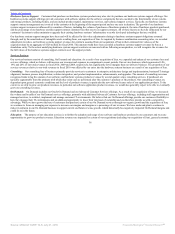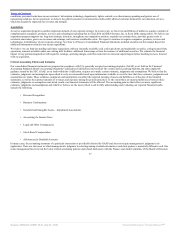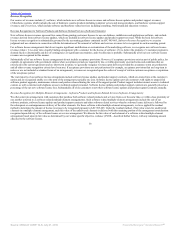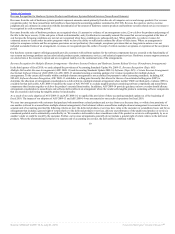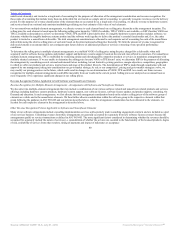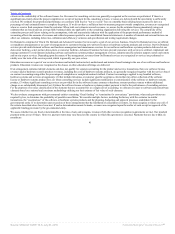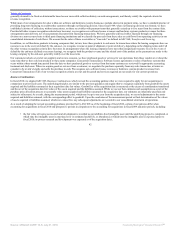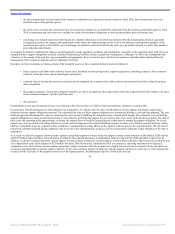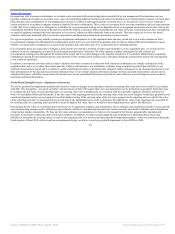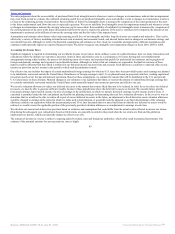Oracle 2009 Annual Report Download - page 39
Download and view the complete annual report
Please find page 39 of the 2009 Oracle annual report below. You can navigate through the pages in the report by either clicking on the pages listed below, or by using the keyword search tool below to find specific information within the annual report.
Table of Contents
Hardware Systems Business
As a result of our acquisition of Sun in January 2010, we entered into a new hardware systems business. Our hardware systems business consists of two operating
segments: (1) hardware systems products and (2) hardware systems support. Our hardware business represented 9% of our total revenues in fiscal 2010 and we
expect that it will continue to add a significant amount of revenues and expenses to our results of operations in comparison to our historical operating results. We
expect our hardware business to have lower operating margins as a percentage of revenues than our software business due to the incremental costs we incur to
produce and distribute these products and to provide support services, including direct materials and labor costs. We expect to make investments in research and
development to improve existing hardware products and services or develop new hardware products and services.
To produce our hardware products, we rely on both our internal manufacturing operations as well as third party manufacturing partners. Our internal
manufacturing operations consist primarily of final assembly, test and quality control of enterprise and data center servers and storage systems. For all other
manufacturing, we rely on third party manufacturing partners. We distribute most of our hardware products either from our facilities or partner facilities. One of
our main goals is to reduce costs by simplifying our manufacturing processes through increased standardization of components across product types, through a
reduction of the number of assembly and distribution centers we rely on and through our transition to a “build-to-order” process in which products are built only
after customers have placed firm orders. In addition, we are focusing on identifying hardware systems support processes that are intended to proactively identify
and solve quality issues and to increase the amount of new hardware systems support contracts sold in connection with the sales of new hardware products.
Hardware Systems Products: Our hardware systems products consist primarily of computer server and storage product offerings and hardware-related
software, including our Solaris operating system.
We offer a wide range of server systems using our SPARC microprocessor. Our SPARC servers are differentiated by their size, cost, form factor or configuration
(rack, blade or stand-alone systems) and customer environments that they target (general purpose or specialized systems). Our mid- and large-size servers are
designed to offer greater performance and lower total cost of ownership than mainframe systems for business critical applications and for customers having more
computationally intensive needs. Our SPARC servers run the Solaris operating system and are designed for the most demanding mission critical enterprise
environments at any scale.
We also offer a wide range of x86 servers differentiated by the same features as our SPARC servers. These x86 systems are substantially based upon
microprocessor platforms from Intel Corporation and are also compatible with Solaris, Linux, Windows and other operating systems.
Our storage products are designed to securely manage, protect, archive and restore customers’ data assets and consist of tape, disk and networking solutions for
open systems and mainframe server environments.
Prior to our acquisition of Sun, the majority of Sun’s hardware systems products were sold through indirect channels. Although we plan to continue to sell our
hardware products through indirect channels, including independent distributors and value added resellers, we have begun enhancing direct sales coverage for
our hardware systems products and intend that our direct sales force will sell proportionately more of our hardware systems products in the future than they do
currently.
Our operating margins for our hardware systems products segment have been and will be affected by the amortization of intangible assets associated with our
acquisition of Sun. In addition, business combination accounting rules require us to record acquired inventories at fair value, which generally will result in an
unfavorable short-term impact to our expenses and operating margins as we sell these acquired inventories to customers in the post-combination period.
We have limited experience in predicting our quarterly hardware systems products revenues. The timing of customer orders and delays in our ability to timely
manufacture or deliver a few large transactions could substantially affect the amount of hardware systems products revenues, expenses and operating margins
that we report.
35
Source: ORACLE CORP, 10-K, July 01, 2010 Powered by Morningstar® Document Research℠


